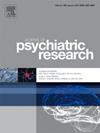纵向分析药物依赖型和复发型精神分裂症患者血液中的星形胶质细胞衍生蛋白水平
IF 3.7
2区 医学
Q1 PSYCHIATRY
引用次数: 0
摘要
最近,星形胶质细胞对精神分裂症神经元回路和精神症状的潜在影响得到了强调。因此,我们分析了急性首发(60 例)和复发(34 例)精神分裂症患者血清中星形胶质细胞衍生蛋白胶质纤维酸性蛋白(GFAP)和脂肪酸结合蛋白 7(FABP7)的水平,并与 94 例匹配的对照组进行了比较。测量在抗精神病治疗前和治疗后 6 周进行。我们发现,与对照组相比,患者的 GFAP(p <0.001)和 FABP7(p <0.001)水平明显较低,首发和复发患者之间无明显差异,治疗后也无变化。在对照组中,FABP7 与年龄呈负相关(r = -0.319,p = 0.002),而在患者中则不然(r = -0.251,p = 0.015)。我们的研究结果表明,GFAP 和 FABP7 的降低可作为精神分裂症星形胶质细胞病理学的特质标记,甚至在抗精神病药物治疗之前也是如此。与对照组相比,精神分裂症患者的 FABP7 与年龄不相关,这可能与精神分裂症患者大脑过早衰老有关。要探索精神分裂症慢性疾病与星形胶质细胞病理学之间的关系,还需要进行长期研究。本文章由计算机程序翻译,如有差异,请以英文原文为准。
Longitudinal analysis of astrocyte-derived protein levels in the blood of drug-naive and relapsed patients with schizophrenia
The potential influence of astrocytes on neuronal circuitry and psychotic symptoms in schizophrenia have recently been highlighted. Human postmortem studies have observed reduced astrocyte numbers in schizophrenia, but whether this pathology is present at disease onset or accumulates progressively with further psychotic episodes remains unclear.
Therefore, we analysed serum levels of the astrocyte-derived proteins glial fibrillary acidic protein (GFAP) and fatty acid-binding protein 7 (FABP7) in acutely ill first-episode (n = 60) and relapsed (n = 34) schizophrenia patients compared to 94 matched controls. Measurements were taken before and 6 weeks after antipsychotic treatment. We found significantly lower levels of GFAP (p < 0.001) and FABP7 (p < 0.001) in patients compared to controls, with no significant differences between first-episode and relapsed patients or changes after treatment. FABP7 negatively correlated with age in controls (r = −0.319, p = 0.002), but not in patients (r = −0.251, p = 0.015). In contrast, GFAP showed no correlation with age.
Our findings suggest that lowered GFAP and FABP7 may serve as trait markers of astrocyte pathology in schizophrenia, even prior to antipsychotic treatment. The absent correlation between FABP7 and age in schizophrenia patients, in contrast to controls, may be related to premature brain aging in schizophrenia. Long-term studies are needed to explore the relationship between chronic disease and astrocyte pathology in schizophrenia.
求助全文
通过发布文献求助,成功后即可免费获取论文全文。
去求助
来源期刊

Journal of psychiatric research
医学-精神病学
CiteScore
7.30
自引率
2.10%
发文量
622
审稿时长
130 days
期刊介绍:
Founded in 1961 to report on the latest work in psychiatry and cognate disciplines, the Journal of Psychiatric Research is dedicated to innovative and timely studies of four important areas of research:
(1) clinical studies of all disciplines relating to psychiatric illness, as well as normal human behaviour, including biochemical, physiological, genetic, environmental, social, psychological and epidemiological factors;
(2) basic studies pertaining to psychiatry in such fields as neuropsychopharmacology, neuroendocrinology, electrophysiology, genetics, experimental psychology and epidemiology;
(3) the growing application of clinical laboratory techniques in psychiatry, including imagery and spectroscopy of the brain, molecular biology and computer sciences;
 求助内容:
求助内容: 应助结果提醒方式:
应助结果提醒方式:


